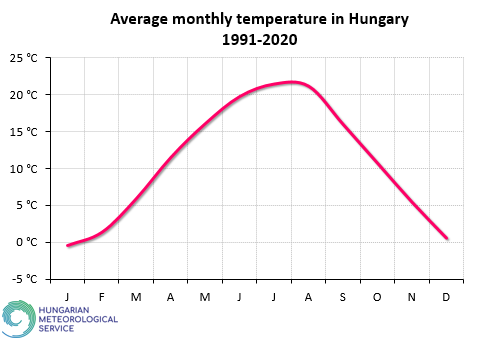The most important factors that influence the large-scale distribution of air temperature are geographical location, altitude above sea level, and distance from the seas. In the period from 1991 to 2020, the average annual temperature in most parts of Hungary ranged between 10 and 11.5 °C.

Figure 1
Annual mean temperature in Hungary based on the 1991–2020 period
The map of the average annual temperature reflects the topography, as well as the warming effect of the Mediterranean Sea and the cooling effect of the Siberian anticyclone, which causes a decrease in the spatial distribution of the annual average temperature in a southwest to northeast direction (Figure 1). The lowest values appear in higher areas such as the Bakony and the Northern Mountains, where the average temperature is generally around 9 °C. In smaller areas such as the Börzsöny, Mátra, Bükk, and Zemplén Mountains, values below 8 °C also occur. In the plain areas, the normal value generally ranges between 10.5 and 11.5 °C, and in some small areas near the southern border the annual average temperature can exceed 11.5 °C.
Although the effect of topography for temperature is evident, situations with temperature inversion often occur in winter, when the temperature does not decrease but increases with altitude. In winter, a common cold layer of air can change the vertical temperature profile. As it rises above the air mass filling the Carpathian Basin, higher-lying areas can become warmer.
On average in the period from 1991 to 2020, January is the coldest month of the year, but in any given year, any winter month can be the coldest. The average temperature in January and generally the average temperature in winter varies from year to year. The weather in summer is more balanced, and the variability of summer temperatures from year to year is generally lower than in winter months. The warmest period of the year is the end of July and the beginning of August (Figures 2 and 3).
The maximum and minimum temperatures are important characteristics of air temperature. In Hungary, the daily temperature range (Tmax-Tmin) shows a characteristic annual variation. The smallest range (4-6 °C) occurs in December when the days are the shortest and the month is the cloudiest. While during the long days and less cloudy summer months, we can experience more than twice as much minimal range (11-13 °C).
Figure 2
Monthly mean temperature of Hungary based on the 1991–2020 period
Figure 3
Lower and upper quartiles and extremes of monthly mean temperature of Hungary based on the 1991–2020 period












